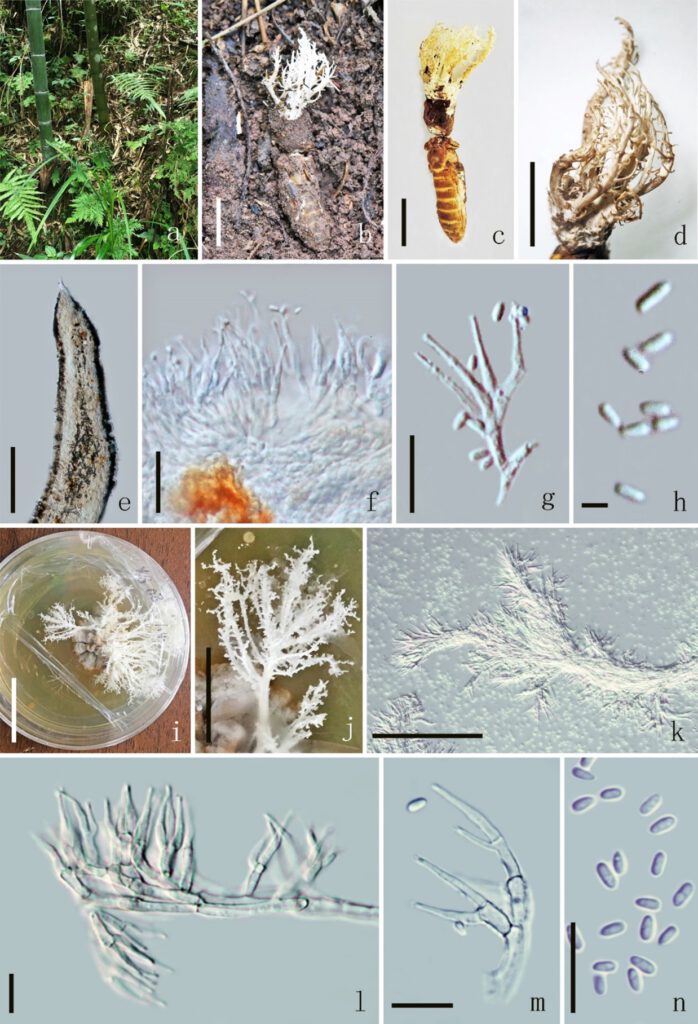Polycephalomyces albiramus Y.P. Xiao, T.C. Wen, J.Z. Sun & K.D. Hyde sp. nov. Fig. 7
MycoBank number: MB 559470; Index Fungorum number: IF 559470; Facesoffungi number: FoF 10732;
Etymology: The species name refers to the pale synemata
Type: Holotype GZU 21-XS08
Parasitism on Gryllotalpa sp. (Orthoptera, Gryllotalpidae) (See Fig. 9). Sexual morph: Undetermined. Asexual morph: Hyphomycetous. Synnemata 1–3 cm long, 1–2 mm wide, arising from the head of larvae, stipitate, gathered, branched, white to pale yellow, numerous, cylindrical and tapering on the top, without fertile head. Stipe 1–3 cm long, 1–2 mm wide, flexuous, white to pale yellow colored, branched. Conidiophores 15–35 µm long ( = 27 µm, n = 60), concentrated, mono-, bi- or terverticillate. Metulae 3.6–5.2 × 1.9–2.3 µm (=4.4 × 2.1 µm, n=60), usually present, as additional branch. Phialides 12.8–18.3 × 1.0–2.2 µm ( = 16 × 1.1 µm, n = 60), hyaline, smooth, narrowly subulate, awl-shaped. Conidia 2.1–3.2 × 0.9–1.2 µm (=2.7 × 1.1 µm, n=60), 1-celled, hyaline, cylindrical to obovoid or subglobose.
Culture characters: Colonies derived from single spore isolation. Colonies on PDA slowly growing, reached to 1 cm diam in 20 days at 25 ℃, gray to dark gray, cottony with high mycelial density, reverse dark brown. Synnemata 1.2–2.2 cm long, 0.2–1 mm wide, stipitate, gathered, white, numerous, cylindrical, branched, conidia masses on the surface, without fertile head. Stipe 0.2–1 cm long, 0.2–1 mm wide, flexuous, white, numerous branched. Conidiophore 14–25 µm long ( = 20 µm, n = 60), concentrated, normally 2 phialides in one, rarely 4 phialides in one. Metulae 4.8–10.2 × 2.2–2.8 µm (=7.5 × 2.5 µm, n=60), usually present, as additional branch. Phialide 10–18 × 1.0–2.2 µm ( = 16 × 1.1 µm, n = 60), hyaline, smooth, narrowly subulate, awl-shaped. Conidia 3.6–4.0 × 0.9–1.2 µm (=2.8 × 1.1 µm, n=60), 1-celled, hyaline, subglobose to obovoid to cylindrical.
Material examined: China, Guizhou Province, Zunyi City. Parasitic in Lepidoptera. in the soil, 22 October 2020, Qingfeng Meng, XS08, (GZU 21-XS08, holotype); (KSH ##### paratypes); culture (GZU 22-XS08)
Notes: The new species Polycephalomyces albiramus is sister to Polycephalomyces formosus (Fig. 2: 98% ML / 1.00 PP) with Cordyceps pleuricapitata branching off (Figs 2-3: 100% ML / 1.00 PP). Polycephalomyces albiramus is distinct from other species of Polycephalomyces in that it parasitizes Gryllotalpa sp. and producing branched synnemata without a fertile head, narrowly subulate phialides and longer conidia (Table 7). Thus, a new species, Polycephalomyces albiramus is introduced.

Fig. 7. Polycephalomyces albiramus (Holotype: GZU 21-XS08) (a–h Fresh specimen of Polycephalomyces albiramus). a Habitat. b, c Overview of Polycephalomyces albiramus. d Synnemata. e Synnema under microscope. f Conidiophores. g Phialidies. h Conidia. (i–n Polycephalomyces albiramus in culture.) i Polycephalomyces albiramus on PDA. j, k Synnemata from pure culture. l, m Conidiophore and phialidies. n Conidia. Scale Bars: b–d, i = 1 cm, j = 5000 µm, e, k = 100 µm, f, g, l, m, n = 10 µm, h = 2 µm.
